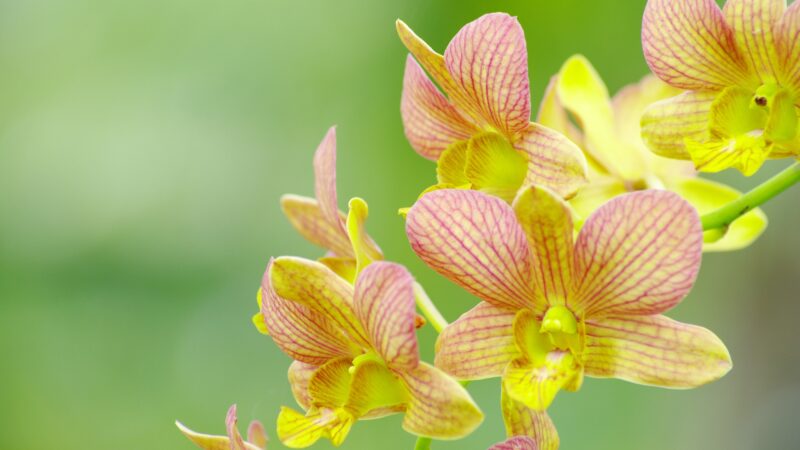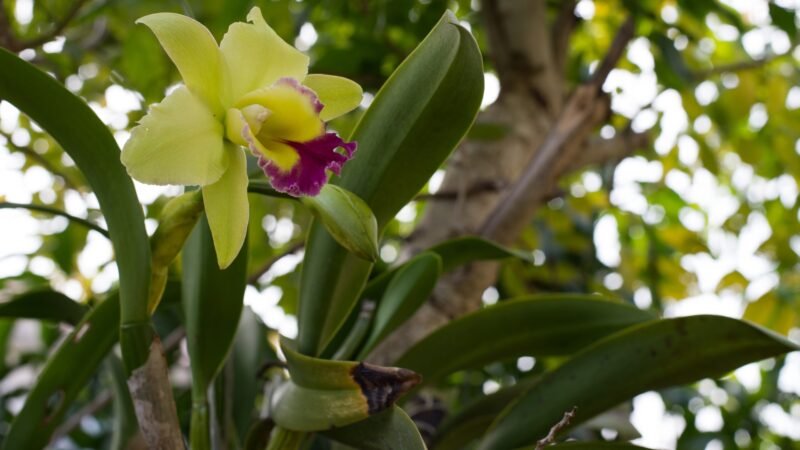Orchids are popular because of their beauty and colorful variety. The fact that they’re easy to care for also makes them a good choice for those who are new to gardening.
However, as hardy as they are, they are still susceptible to diseases. And the first thing you have to look out for is its leaves turning yellow.
Orchid leaves may turn yellow as part of their natural cycle. However, yellow leaves may also be a cause for concern, especially if it was due to the following reasons:
- Overwatering
- Underwatering
- Exposure to too much sunlight
- Being fed with too much fertilizer
- Exposure to non-ideal temperatures
- Nutrient deficiency
- Potting stress
- Fungal or bacterial infection
This list is just the tip of the iceberg. If you want to know more about each cause and how to save your orchids, then you came to the right place. This article will provide you with all the information you need to save your yellow-leaved orchids.
How to Know If Yellowing Leaves in Your Orchid is Natural?

Having yellowing leaves on your orchid doesn’t always mean that it is dying. Just like other plants and trees, an orchid’s leaves also go through a natural cycle wherein it wilts and naturally fall off of the plant. This is to give way to new leaves and flowers to grow in their place while also signifying a change in the seasons.
But, how would you be able to tell if the yellowing leaves in your orchid are part of its natural processes? Here are some pointers to look out for:
- The yellowing leaves are usually at the bottom of the plant. If you find that only the leaves at the bottom of the plant are turning yellow, then that’s the biggest sign that it is wilting naturally.
- All other parts of the orchid seem healthy. If all other leaves and stalks look green and healthy, and the flowers do not have browning parts, then that signifies that the plant is perfectly healthy. This is a sure sign that the yellowing leaves are simply near their life cycle.
- The yellowing is not accompanied by other symptoms. The biggest sign that a plant is wilting unnaturally is the presence of brown spots all over its yellowing leaves. At times, this is also accompanied by drying or rotting tips on the petals or leaves. But without these other symptoms, then there’s a big chance that the yellowing leaves on your orchis are natural.
8 Reasons Why Orchid Leaves Turning Yellow

Overwatering
Like most plants, overwatering your orchids is one of the prime suspects for their leaves turning yellow.
While orchids need water to stay hydrated and absorb the nutrients found in the soil, overwatering can easily cause damage to their roots and leaves. Not to mention, it might attract fungi and other microorganisms that thrive in moist environments.
Signs that you have overwatered your orchid include yellow leaves that have a leathery texture. Aside from the yellowing leaves, you may also observe that they will seem to be drooping or lifeless. While they’re yellow, they do not look dry or wilting, which means that it is not a natural occurrence.
How to Save the Orchid Leaves?
Fortunately, it’s possible to save an overwatered orchid. The best solution is to repot your orchid. By uprooting your orchid from its old pot, you can also observe if some of its roots were damaged by the water and separate them accordingly.
Then, you can move it to a new pot with excellent drainage properties, like the Solar Store Plastic Orchid Pot. Make sure to use new soil only since the old soil may already be teeming with fungal growth.
- 【Dimension& Package】Double orchid pot measures 7-inch in...
- 【Orchid Pots with Holes】The roots of orchids need fresh air...
- 【Dual-pot Design】Made of sturdy plastic materials,the plastic...
- 【Advantage】Plastic orchid pot set is a small gap all around...
- 【Great Solution for Starving More Room】The inner basket of...
Related: Best Orchid Pots and Containers | Buyers’ Guide
Underwatering
In contrast to overwatering, not giving your orchid enough water will also cause yellowing leaves. While orchids only need around three ice cubes worth of water per week, leaving them without any for prolonged periods may cause dehydration. And if you don’t make any immediate intervention to save it, it will wither and die eventually.
When a plant is underwatered, its leaves turn yellow with a wrinkled appearance. You will also notice that flowers – including young buds – will start to fall. The entire plant will also have a lifeless appearance.
How to Save the Orchid Leaves?
To save a dehydrated orchid, simply sprinkle the water directly into its leaves and soil. Do so for a few days until the orchid will look like it has recovered.
However, make sure not to put too much water – otherwise, it might be at risk of being overwatered. Light sprinkling will suffice.
Too Much Sunlight
Another reason why orchid leaves turn yellow is their exposure to direct sunlight for extended periods. At most, an orchid only needs around 12 to 14 hours of sunlight per day. If it is exposed to the sun for more than the recommended time frame, its leaves become burned.
Signs of too much sunlight in an orchid include pale yellow leaves with black spots. At times, the leaves will also have brown dried tips. And in case of prolonged exposure, the entire plant will look pale and dry.
How to Save the Orchid Leaves?
In the case of prolonged exposure to direct sunlight, the best way to save the orchid is to take the plant indoors until it has recovered. Ideally, the indoor temperature should be around 65 to 75°F.
While it is recovering, make sure it still gets enough sunlight, although indirectly. It is also advised to sprinkle it with more water than usual since it may also be dehydrated.
Also, once you notice that the orchid is recovering, you should separate the leaves that have completely dried up or are starting to rot. By doing so, the orchid will look healthier.
Too Much Fertilizer
While the main role of fertilizers is to help plants grow faster and healthier, too much of it can be detrimental to orchids – or any plant, for that matter.
When fed with too much fertilizer, or if the fertilizer is too strong for the plant, the orchid may not bloom flowers. You can also observe browning at the tips of its yellowing leaves.
How to Save the Orchid Leaves?
Since the fertilizer is already incorporated into the soil, then the best solution to save your orchid is to repot it. Move the plant into a new pot with fresh and clean soil.
Then, make sure to use a fertilizer with balanced nutrient content, like Peter’s Professional 20-20-20 General Purpose Water Soluble Fertilizer. Then, continue to give your orchid its needed sunlight and water until it has recovered.
Related: When to Use Orchid Food? | 10 Best Orchid Fertilizers
Too High/Low Temperature
It bears to stress that orchids are tropical plants. As such, it thrives in warm environments. Particularly, it prefers a daytime temperature between 75 to 85°F and a nighttime temperature not lower than 65°F.
As tropical plants, orchids may suffer from severe damage in case the temperature becomes too cold. This is especially true if it has been exposed to a sudden blast of freezing air. In contrast, orchids may not grow to their ideal size if the temperature is too hot.
How to Save the Orchid Leaves?
In the case of exposure to temperatures beyond an orchid’s ideal range, the right thing to do is to keep it inside your home for a while. This is especially true during the winter months when temperatures drop to freezing numbers.
While inside your home, you can adjust the temperatures to what’s ideal for your orchid. Also, make sure to water them and give them exposure to indirect sunlight to keep them healthy.
Nutrient Deficiency
While too much fertilizer can cause browning tips on yellowing leaves, not feeding them any leads to nutrient deficiency. As a result, your orchids may suffer from pale, anemic-looking leaves with their tips curled up.
But even if you give them fertilizer, orchids may suffer from a nutrient deficiency if the soil does not support proper nutrient absorption.
How to Save the Orchid Leaves?
In case your orchids suffer from nutrient deficiency, the best way to resolve the issue is to replant your orchid. As much as possible, use a potting mix that helps orchids absorb the nutrients better, such as the Sun Bulb 5011 Better-Gro Phalaenopsis Mix.
- Phalaenopsis mix
- It is a fertile mixture of Canadian chunk peat blended with...
- It is developed to provide the proper mixture of fertilizer and...
- Provides your phalaenopsis orchids with the drainage, air flow,...
- It should be used when re-potting your orchid, at least every...
However, if the damage seems severe, you can opt to use liquid fertilizer. Liquid fertilizers are easier to spread and are absorbed at a faster rate by the roots. A good example is the Premium Orchid Food Fertilizer Spray, which you can mist directly onto your orchids.
- READY TO USE FORMULA: Enjoy the convenience of our pre-mixed...
- SAFE AND GENTLE FORMULA: Orchid safety is our priority. The...
- PROMOTES ORCHID BLOOMS AND GROWTH: Unlock the full potential of...
- VERSATILE FOR ALL ORCHID TYPES: Whether you're nurturing a rare...
- HIGHEST QUALITY FERTILIZER: Proudly made in the USA, our...
Potting Stress
Orchids need regular repotting, especially when there seems to be an overgrowth of their roots that already made their way out of the pot. Repotting will also help it bloom more flowers, so there’s no denying that it’s a regular maintenance activity for orchids.
However, repotting them too frequently can cause them stress. As a result, their leaves may turn yellow. And the worst part about it is that it might even prevent the flowers from blooming.
How to Save the Orchid Leaves?
To save an orchid from potting stress, it is advised not to re-pot them as frequently as once a year. If you have just repotted your orchid, leave it there for a year or two before deciding to move it to another pot. Then, take care of your orchid as you usually would.
Fungal/Bacteria Infections
Like all plants, orchids are also susceptible to fungal and bacterial infections. This usually results from overwatering coupled with poor air circulation – leaving the soil moist and attractive to fungi, bacteria, and pests.
Unfortunately, fungal and bacterial infections can easily lead to root rot, yellow leaves, and yellow stems. If the yellowing usually starts from the stem, that’s always the first sign of an infection.
How to Save the Orchid Leaves?
It may take a while to save an infected orchid, but it’s definitely possible. With a clean pruning shear like the VIVOSUN 6.5 Inch Gardening Scissors Hand Pruner Pruning Shear, you should carefully remove the infected parts of the plant.
- Curved Blades: Be note that the blades of blue color pruner is...
- Reduce Hand Strain: These micro tip snips are built spring-loaded...
- Secure, Easy to Lock: These micro tip snips feature a safe and...
- Make Precise Cuts: With these micro tip snips, you can easily get...
- Applications: Tackle all of your deadheading, trimming, and...
You may also opt to transfer it to a new pot so you can check if the roots are rotting. In case of root rot, you may also separate the infected parts to prevent their spread towards the healthy parts.




